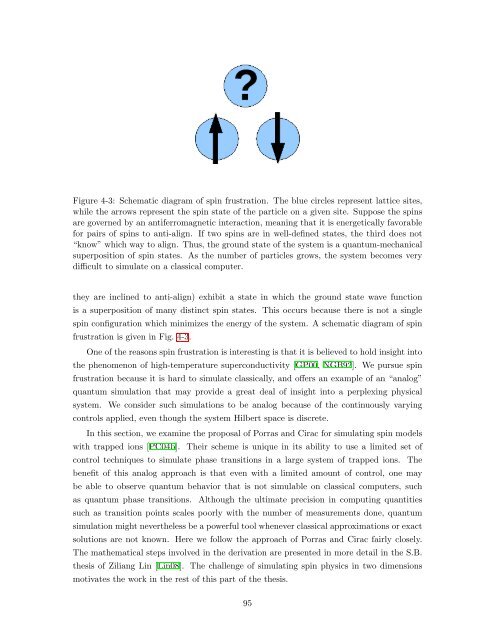Ph.D. Thesis - Physics
Ph.D. Thesis - Physics
Ph.D. Thesis - Physics
Create successful ePaper yourself
Turn your PDF publications into a flip-book with our unique Google optimized e-Paper software.
Figure 4-3: Schematic diagram of spin frustration. The blue circles represent lattice sites,<br />
while the arrows represent the spin state of the particle on a given site. Suppose the spins<br />
are governed by an antiferromagnetic interaction, meaning that it is energetically favorable<br />
for pairs of spins to anti-align. If two spins are in well-defined states, the third does not<br />
“know” which way to align. Thus, the ground state of the system is a quantum-mechanical<br />
superposition of spin states. As the number of particles grows, the system becomes very<br />
difficult to simulate on a classical computer.<br />
they are inclined to anti-align) exhibit a state in which the ground state wave function<br />
is a superposition of many distinct spin states. This occurs because there is not a single<br />
spin configuration which minimizes the energy of the system. A schematic diagram of spin<br />
frustration is given in Fig. 4-3.<br />
One of the reasons spin frustration is interesting is that it is believed to hold insight into<br />
the phenomenon of high-temperature superconductivity [GP00, NGB92]. We pursue spin<br />
frustration because it is hard to simulate classically, and offers an example of an “analog”<br />
quantum simulation that may provide a great deal of insight into a perplexing physical<br />
system. We consider such simulations to be analog because of the continuously varying<br />
controls applied, even though the system Hilbert space is discrete.<br />
In this section, we examine the proposal of Porras and Cirac for simulating spin models<br />
with trapped ions [PC04b]. Their scheme is unique in its ability to use a limited set of<br />
control techniques to simulate phase transitions in a large system of trapped ions. The<br />
benefit of this analog approach is that even with a limited amount of control, one may<br />
be able to observe quantum behavior that is not simulable on classical computers, such<br />
as quantum phase transitions. Although the ultimate precision in computing quantities<br />
such as transition points scales poorly with the number of measurements done, quantum<br />
simulation might nevertheless be a powerful tool whenever classical approximations or exact<br />
solutions are not known. Here we follow the approach of Porras and Cirac fairly closely.<br />
The mathematical steps involved in the derivation are presented in more detail in the S.B.<br />
thesis of Ziliang Lin [Lin08]. The challenge of simulating spin physics in two dimensions<br />
motivates the work in the rest of this part of the thesis.<br />
95
















